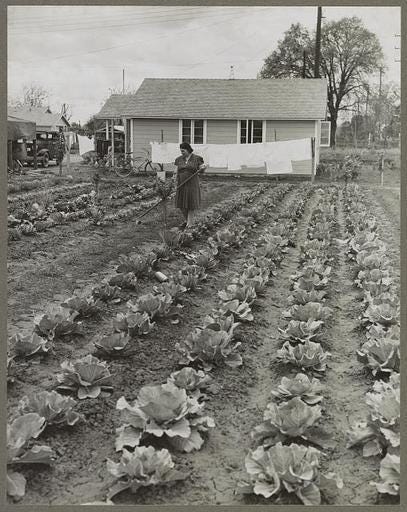Back to Gardening Chapter 4, Design - Part B: Paths and Beds
In this section of Chapter 4 I review options for garden paths.
Back to Gardening Chapter 4, Design - Part B: Paths & Beds
When I was a kid, most of the gardens in my neighborhood were of a similar design, consisting a big square or rectangle cut out of the backyard with rows of vegetables separated by parallel paths for tending the garden between each row. It was an effective design, but I don't think it's the best way to use a space for gardening, because each garden has almost as much space devoted to growing things as it does for walking.

There are two main things that compete for space in a garden - plants and gardeners. Plants need fertile, well drained soil. Gardeners need room to work and move around. In a sense, these two needs are in conflict. Good soil does not benefit from being walked on. By contrast, if we think of an ideal walking surface (like a sidewalk), it is practically the antithesis of an ideal growing space. Of course the solution to this funny problem is to think of a garden as place with two types of spaces: (1) spaces for growing things (beds); and , (2) spaces to walk and move around (paths). The former needs to be an oasis, whereas the latter can be as lifeless as a desert.
Paths
To tend a garden, the gardener needs enough room for at least one person to walk, kneel, use tools, and do other things like push a wheelbarrow. This means that every garden must sacrifice some of it's potential growing space for paths. On the bright side, this means that the paths do not need to have excellent soil, and in fact, the less excellent they are in that regard the better, because the ideal path will be good and firm for operating a wheelbarrow, and have no weeds... because who needs more weeds? There are many potential materials for garden paths, so here are a few suggestions.
Nothing (bare earth) costs nothing. It can be firm, but can become muddy with rain. No matter how poor the soil, it will become a weed bed, and those weeds will find their way into the vegetable beds. In terms of maintenance, it will need
Keep reading with a 7-day free trial
Subscribe to The Maritime Gardening Newsletter to keep reading this post and get 7 days of free access to the full post archives.



